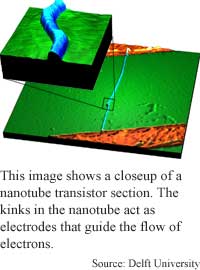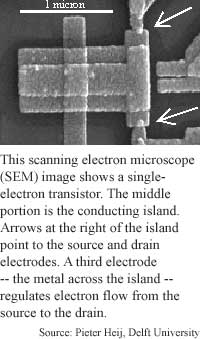
Nanotube
kinks control current
By
Chhavi Sachdev,
Technology Research NewsThe steady increases in computer speed we’ve gotten used to over the past four decades are largely due to the shrinking of transistors. Smaller transistors mean shorter paths for electrical current to signal the ones and zeros of digital computing, which in turn speeds the process. Only a dozen years ago, the state-of-the-art 486 sported 1.2 million 1-micron transistors. Today’s Pentium 4 packs 42 million 100-nanometer transistors.
Researchers at Delft University of Technology in the Netherlands are trying to lower the transistor size barrier much further with a single-electron transistor (SET) made of a single-wall carbon nanotube that is 1.5 nanometers wide and about 50 nanometers long. A nanometer is a millionth of a millimeter.
To create the nanotube transistor, the researchers used an atomic force microscope (AFM) to put two kinks in a nanotube. “We have strongly bent, or buckled, a nanotube twice with an atomic force microscope. In this way, we created an ultra-tiny conducting island within the nanotube,” said Cees Dekker, a professor in applied physics at Delft University of Technology in the Netherlands.
In the nanotube, the area between the kinks is the island, or conducting part, and measures about 25 nanometers in length. Using a single nanotube as a transistor is the ultimate level of miniaturization, according to Dekker.
Today’s current state of transistor miniaturization allows about 750 transistors to fit in 3 square millimeters, which is about the size of the average flea. More than 100,000 of the nanotube transistors could fit in the same area.
The nanotube transistor, which resembles a slightly mistreated drinking straw, uses a single electron rather than the several million required to turn on a typical computer transistor today. The key to the tiny transistor is its ability to function at room temperature.
Single-electron transistors have historically required severely low temperatures because the energy of warmer molecules drowns out a single electron’s signal. The researchers got around this central problem by reducing the size of the transistor. At the nano scale, heat fluctuations don’t matter.
“As a rule of thumb, the smaller the device, the larger the charging energy for a single electron is,” said Henk Postma, a graduate student at Delft. “If the charging energy associated with [passing] a single electron is larger than the energy you have available from temperature and bias voltage, the current cannot run and you have a functioning SET,” he said. “Our device is so small, that the charging energy is large enough to operate at room temperature.”
In a transistor, electrons flow from a source electrode to a drain electrode through the island. At two ends of the island are junctions that connect the island and the electrodes. On either side of the island are gates. When there is no voltage moving through the gates, electrons are blocked from moving through the island. Current flowing through the gates turns the transistor on allowing electical current to flow from the source to the drain.
Electrons flow through the nanotube transistor by tunneling through one by one. When electrons tunnel, they exhibit that peculiar quantum trick of disappearing, then reappearing somewhere else without traversing the space between. As one electron tunnels from the island to the drain electrode, another electron takes its place by tunneling from the source electrode to the island, a process known as coupling.
“In conventional SET's, people believe that electrons hop onto the island and off the island in an uncoupled manner…the electron that hops on does not know about the electron that hops off the island. We have shown in our experiment that the electrons in our device only hops on when another electron hops off,” said Postma.
This correlated, or coupled tunneling, is like entering a subway station by dropping a coin into a turnstile machine. While the coin is traveling to the belly of the machine, you can’t enter the station. When the coin has settled in, the turnstile rotates just once to let a person through.
The research is novel because the whole device is one single molecule and it operates at room temperature, said Jie Han, a research scientist of Nanotechnology at NASA’s Ames Research Center. “This may have future applications in nanoelectronics if metallic tubes can be made and buckles can be created in a controlled and large-scale manner,” he said.
“[The] work definitely will get attention from the general body of research on SET's [because it is] a molecular solution to SET technology and application. However, it cannot be expected that many researchers will be able to improve or even repeat this work. It is still very difficult to only make metallic tubes and then to buckle them in right positions,” Han said.
The researchers are currently working on nanotube logic and the issue of assembling nanoelectronics, Dekker said. The device will not be applied in nanoelectronics for at least a decade, he said.
Dekker and Postma’s research colleagues were Tijs Teepan, Zhen Yao, and Milena Grifoni of Delft University. They published the research in the July 6, 2001 issue of the journal Science. The research was funded by the Dutch Foundation for Fundamental Research on Matter (FOM) and the European Community’s SATURN research network.
Timeline: >10 years
Funding: Government
TRN Categories: Nanotechnology; Integrated Circuits; Quantum Computing
Story Type: News
Related Elements: Technical paper, "Carbon Nanotube SET at Room Temperature," Science, July 6, 2001.
Advertisements:
September 12/19, 2001
Page One
Internet stays small world
Tools automate computer sharing
Nanotube kinks control current
Hydrogen chip to fuel handhelds
Scheme harnesses Internet handshakes


News:
Research News Roundup
Research Watch blog
Features:
View from the High Ground Q&A
How It Works
RSS Feeds:
News
Ad links:
Buy an ad link
| Advertisements:
|
 |
Ad links: Clear History
Buy an ad link
|
TRN
Newswire and Headline Feeds for Web sites
|
© Copyright Technology Research News, LLC 2000-2006. All rights reserved.